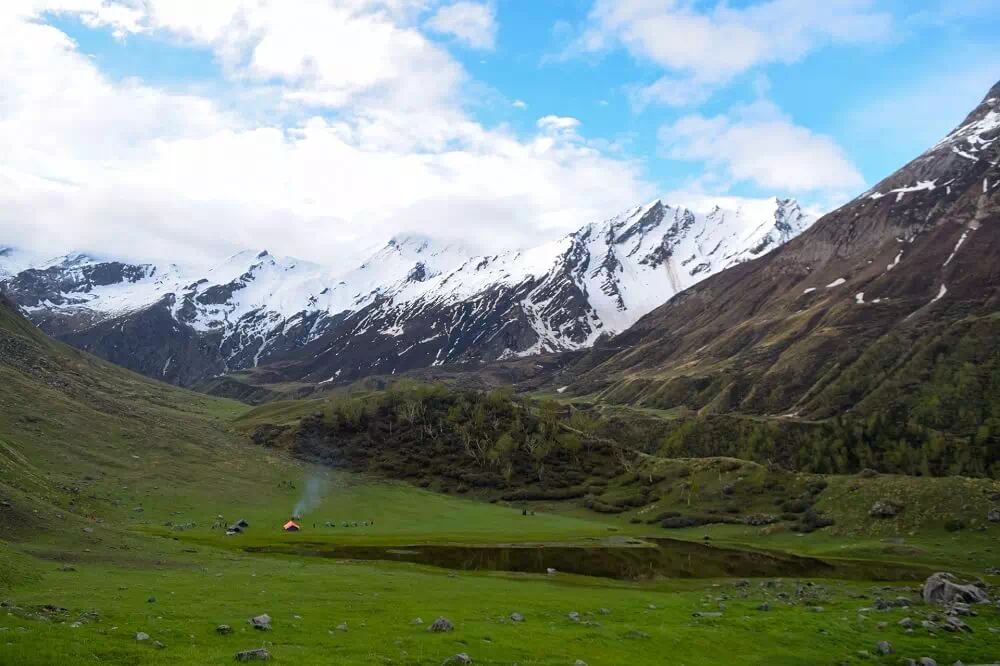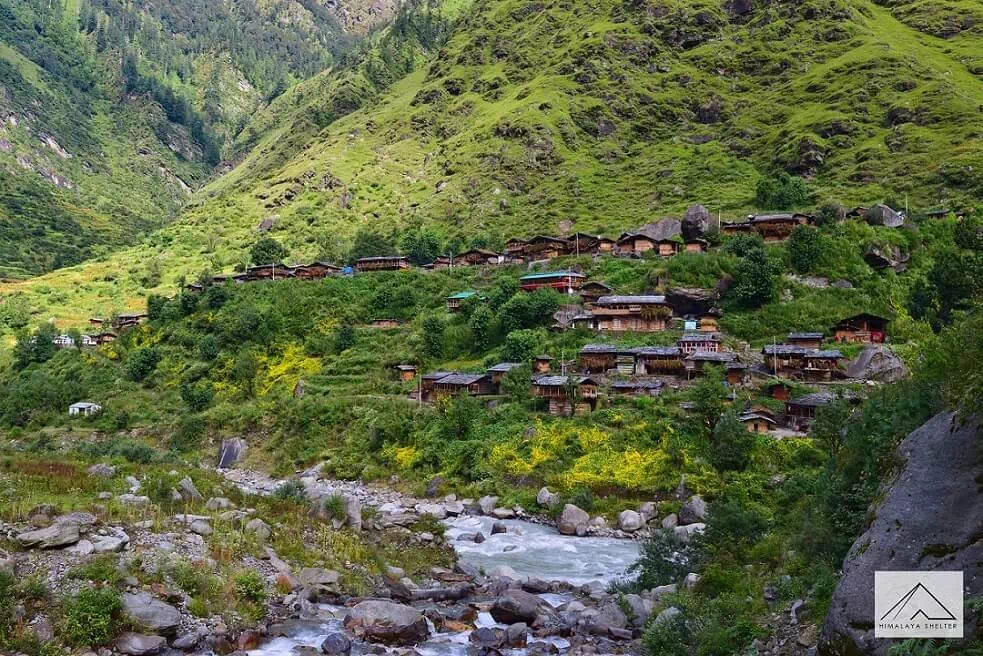

 Gangaad Village - Lost in Space and Time
Gangaad Village - Lost in Space and Time
 Ruinsara Lake and in the backdrop the ridge with Rhododendrons. Beyond the ridge lies the river Supin.
Furthermore, The snow covered peaks in the background offer for an even more compelling view, rendering the trek very unique.
Ruinsara Lake and in the backdrop the ridge with Rhododendrons. Beyond the ridge lies the river Supin.
Furthermore, The snow covered peaks in the background offer for an even more compelling view, rendering the trek very unique. On the first day of your Har ki Dun Trek schedule, you will be heading to a little village in the Garhwal Himalayas named Sankri which is the base village of Har ki Dun Trek. It is located at around 190+ kilometre of distance from the city of Dehradun. The drive to this village is as enchanting as the views of the Garhwal Himalayas from this little hamlet of Sankri. On the way to Sankri, you would also be passing by the famous hill station of Mussoorie. Also, there would be several waterfalls welcoming you on the roads.
After crossing the villages like Purola and Netwar, just a few kilometres before you are about to reach this village, you would be entering the Govind Wildlife Sanctuary. It is originally named as Govind Pashu Vihar National Park. The sight of the peaks like Swargarohini, Bandarpoonchh beyond the roaring waters of Tons river lures most travellers and trekkers to this magical forest. The wild animals of this sanctuary also bring thousands of wildlife lovers to the villages located in its vicinity. To be specific, wild boars, musk deer, black and brown Himalayan bears, fishing cat, leopard cat, serow, goral, and barasingha in this mysterious forest gives its visitors a thrilling experience. Throughout your trek to Har Ki Dun Ruinsara Lake, you have a chance of spotting some of the 150 species of Himalayan birds dwelling in this region.
And the village of Sankri offers you the best of this splendid natural heritage. The night camping here in the step gardens and fields of Sankri is an experience in itself. Sankri village is a famous base camp even for the other treks like Kedarkantha, Bali Pass Trek and even Rupin Pass Trek.
From the base camp, you shall be riding in a local jeep, passing through the rough hilly terrain. Get ready to cross the stream and gushing waterfalls on your adventurous jeep ride. After a crazy ride on the topsy-turvy roads of the Garhwal Himalayas, you would be dropped near the Taluka Village. From here, your journey of traversing through the flowery meadows and turbulent streams starts. The villages along the trek route are also a sight to admire. Belonging to the era when this valley was a part of Duryodhan’s empire, these villages project a unique culture. Perched on the hillocks, the tiny hamlets looks like straight from the fairytale books.
The trekking route doesn’t include much of a steep ascent. River Supin would be gushing-by all along your trekking route to the Har Ki Dun Valley. After a stiff climb by crossing the Seema-Osla Bridge over a stream, you would reach one of the ancient villages of Har Ki Dun Valley.
The village here is known for the only surviving temple of Duryodhan where they have placed the deity of Someshwara. Until very recently, the people of the village followed the tradition of Mahabharata. The alluring view of the valley can best be admired from almost every house in this tiny village. You can also explore the handlooms run in small houses. The ladies here stitch the best woolen products that are exported to the markets all over India. People visiting this valley usually do not miss this chance of buying straight from the weavers.
As we start the days trek we realize the shee magnificence of the landscape surrounding Osla – full of terraced farms. The colors of these lands differ in every season. The red farms of Cholai (Amaranth) look amazing and can be seen from late monsoon. Osla is the last village on the route to Har ki Dun. From Osla the trail gradually rises higher and the river can be seen far below. We come across a temple some distance below the trail towards the right. We pass through bushes of flowers like orchids, fleece flowers and sunflowers. The ascending path climbs high above the confluence of Supin river and the river from Ruinsara valley. From near this confluence, we get a view of the snow-clad peaks of Ruinsara valley including Black Peak, the highest peak in the region.
The journey today is rather short, which gives the opportunity to acclimatize to the high altitude and prepare for the next days journey. We can take a breather basking in the sun at the beautiful campsite of Kalkatidhar. The ban to camp at Har Ki Dun has had a rather positive outlook to the trekking itinerary, as it allows for more comfort & at the same time preserves the natural beauty of Har Ki Dun.
The days trek can be considered to be rather long as we today visit Har Ki Dun and Marinda Tal, a small lake formation due to the obstructing boulder across the river stream, which lies 2 KM further ahead of Har Ki Dun. As we start the trek, at a short distance a hidden and roaring waterfall is encountered with a small tea shop beside the waterfall.
After traversing higher up along the true right of the river, we enter the final stretch which is inside a forest. The forest opens up into the main camping area of Har ki Dun, right beside the gurgling stream. This is a very panoramic spot in Har ki Dun located at the junction of two valleys, one originating from Jaundhar glacier and the other from beyond Hata glacier. Higher up towards the North we can spot the Forest Rest House, while the wood crafted GMVN guest house lies further up in the distance. The Har ki Dun peak stands tall right in front of us behind the Forest Rest House. Towards its left, Hata peak which is usually snow covered can be seen. The minor ridge to our right, lined with a few scattered Himalayan birch trees Bhojpatra separates us from the massive Har Ki Dun valley that goes up all the way to the base of Swargarohini Peak. The paper like bark of these trees was used in ancient times to write religious scriptures.
The vast open meadows following the course of the Supin river can be explored. Further ahead of the meadows one can walk among the forests of Bhojpatra trees (Himalayan birch) or get a closer glimpse of the Jaundhar glacier and Swargarohini peak, for which we will have to head updwards the Har Ki Dun valley, towards the Swargaroini peak in the eastern direction.
We can choose to relax and soak in the environment for some time before we continue our trek to Boslo.
A moderate trek of around 6-7 km would first lead you to the same trail towards Osla village. It then moves downhill towards the Ruinsara Valley. A few kilometres of trail of this Ruinsara trek, before reaching the camping grounds near the waterfall, passes through the dense forest. The age-old trees on this trek seem to be kissing the sky. The forest then eventually opens into a vast green land. The open grassy meadows with the whispering sound of the tumbling waterfall make for a perfect campsite. The sky, on a no moon, the night can be seen studded with twinkling stars. The campsite of Untigad is marked by the sudden onset of Bhojpatra trees and a stark change in landscape with the valley widening. We camp here some 1.5 km short of the lake.
Early in the morning, the trek starts for a short ascent to Ruinsara Lake located at an altitude of 3600 m. The lake, as we know, is considered sacred. Some rituals are also performed by the locals on auspicious occasions. The flora and Fauna of this valley can be easily differentiated with the hills flanked by rhododendron and birch trees. The lake is located on flat grassy land surrounded by snow-clad mountains. The green bushes of Rhododendron (locally known as ‘Buransh’) can be seen loaded with some pink and purple flowers. The juice obtained from the same flowers is used to make local drinks and jam. Honey obtained from these flowers is also one of the specialties of the region. The flowers are supposed to have a healing effect on many discomforting diseases.
The reflection of the Valley in Ruinsara Tal with bright azure sky makes for a charismatic camping experience. The trek is neither too long nor tiring. Thus you can spend the evening gazing at the sky set on fire by the setting sun. The lake area also allows you to take a short walk with your buddies. You can head towards the base of Swargarohini or the Black Peak. Beyond this lays the route of Dhumdar Kandi Pass Trek which is another enthralling trek in this valley. The Photographers may expect to capture some captivating vistas.
The return 16 km long trek would be completed in no time as it is a constant descent with a few kilometres of exception. While heading back to Seema village you can bid a final goodbye to all the small huts, streams, flowers and the mighty hills. While enjoying an easy descent the group can stop for some last-minute pictures of the Har ki Dun Valley too. Enjoying your packed lunch with this view would be like a cherry on the cake. After crossing the same bridges, streams and the villages as you did on the third day, you would finally reach by evening to Seema Village. Night camping shall be done in the outskirts of this little village.
Taking the path along the Supin River, we retrace our steps ahead of Seema, which is at an hour and a halfs’ trek at most and consecutively another 1-2 hours for Gangaad. We spend the day around the village.
Early in the morning, we bid farewell to the village and trek till Taluka. A vehicle from Taluka takes us back to Sankri, where we retire for the day in camps or a guest house.
Taking the path along the Supin River, the group departs for the pickup point at Taluka on Day 8 of this Har ki Dun Ruinsara Lake Trek. By now, the jaw-dropping sceneries that you have left behind would already make you miss your trekking moments. Soon you would be reaching Taluka Village where you can board on the jeeps for another round of a crazy ride to Sankri.
Following the same serpent-like moving roads you would move back to the city of Dehradun with the wonderful memories of the Har ki Dun trek. On the drive back the stretch along Mori where the road runs parallel to river on almost same altitude is bound to leave you nostalgic about the region. You can return for a future trek as the region has plenty of trekking routes, some of which are barely explored. You can also choose to get off at Mussoorie if you have an extra day left to explore this hill station.
The trek slope is low in gradient, which makes it easy to walk. The trek challenges through its distance and on many days we are required to walk long distances.
Weather of Har Ki Dun and Ruinsara trek changes based on the season. The summer months from April to June are a great time to visit, and so is Autumn, from September to October. The trek closes in monsoon and winter months, in late November.
Reviews
There are no reviews yet.